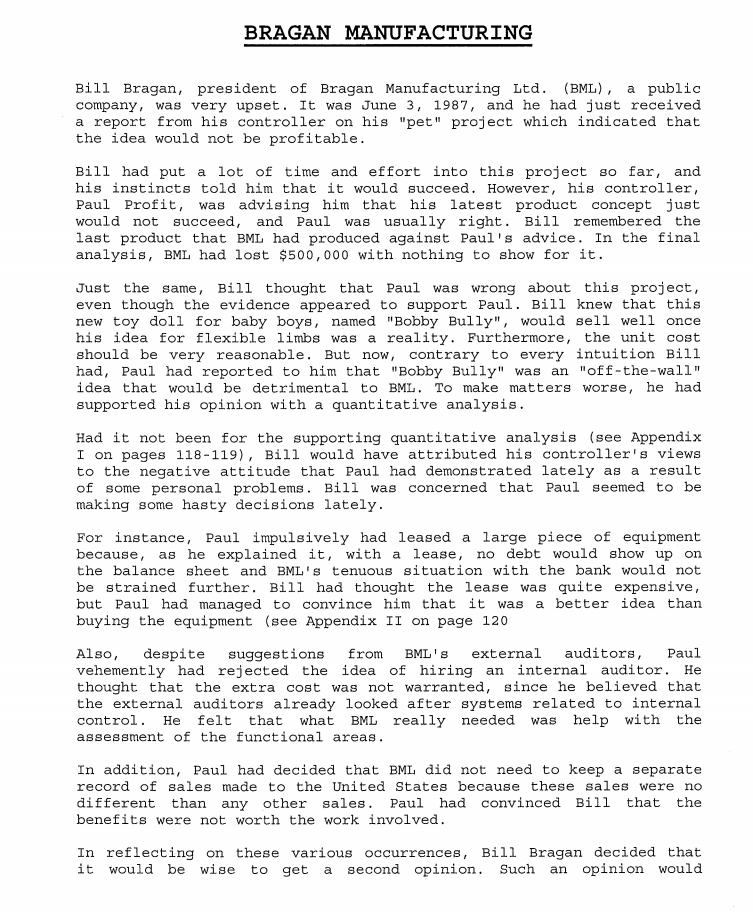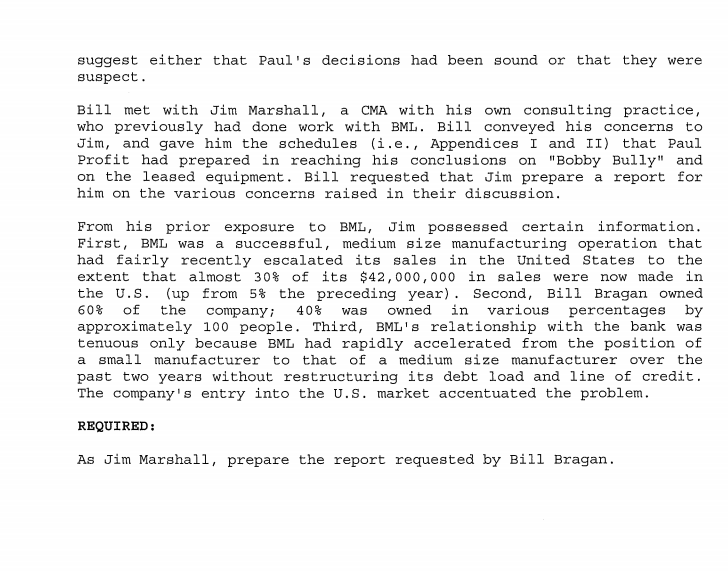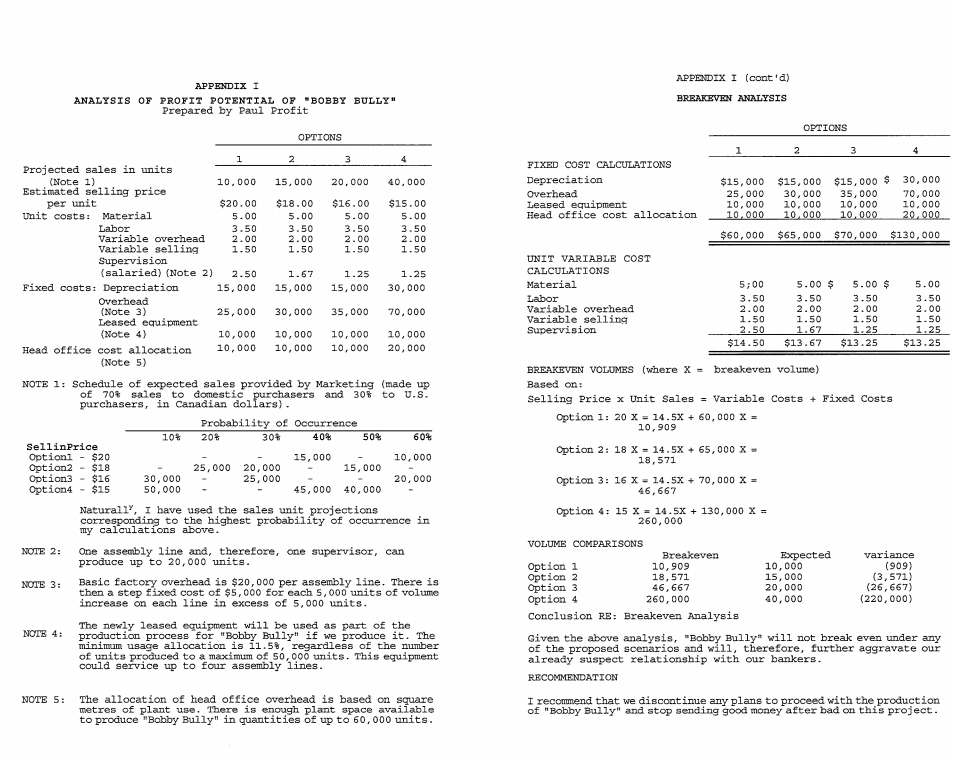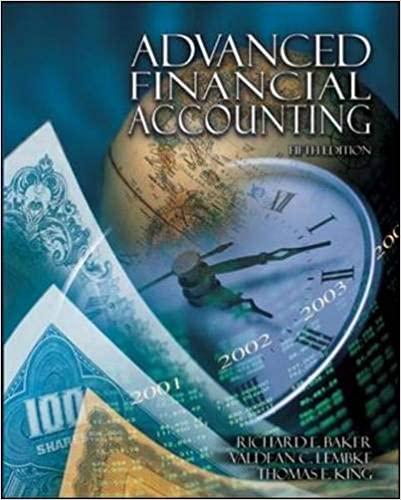Answered step by step
Verified Expert Solution
Question
1 Approved Answer
please help asap ... Identify the ISSUES , ANALYSIS (QUALITATIVE AND QUANTITATIVE), and RECOMMENDATIONS.. BRAGAN MANUFACTURING Bill Bragan, president of Bragan Manufacturing Ltd. (BML), a


 please help asap ...
please help asap ...
Identify the ISSUES , ANALYSIS (QUALITATIVE AND QUANTITATIVE), and RECOMMENDATIONS..
BRAGAN MANUFACTURING Bill Bragan, president of Bragan Manufacturing Ltd. (BML), a public company, was very upset. It was June 3, 1987, and he had just received a report from his controller on his "pet" project which indicated that the idea would not be profitable. Bill had put a lot of time and effort into this project so far, and his instincts told him that it would succeed. However, his controller, Paul Profit, was advising him that his latest product concept just would not succeed, and Paul was usually right. Bill remembered the last product that BML had produced against Paul's advice. In the final analysis, BML had lost $500,000 with nothing to show for it. Just the same, Bill thought that Paul was wrong about this project, even though the evidence appeared to support Paul. Bill knew that this new toy doll for baby boys, named "Bobby Bully", would sell well once his idea for flexible limbs was a reality. Furthermore, the unit cost should be very reasonable. But now, contrary to every intuition Bill had, Paul had reported to him that "Bobby Bully" was an "off-the-wall" idea that would be detrimental to BML. To make matters worse, he had supported his opinion with a quantitative analysis. Had it not been for the supporting quantitative analysis (see Appendix I on pages 118-119), Bill would have attributed his controller's views to the negative attitude that Paul had demonstrated lately as a result of some personal problems. Bill was concerned that Paul seemed to be making some hasty decisions lately. For instance, Paul impulsively had leased a large piece of equipment because, as he explained it, with a lease, no debt would show up on the balance sheet and BML's tenuous situation with the bank would not be strained further. Bill had thought the lease was quite expensive, but Paul had managed to convince him that it was a better idea than buying the equipment (see Appendix II on page 120 Also, despite suggestions from BML'S external auditors, Paul vehemently had rejected the idea of hiring an internal auditor. He thought that the extra cost was not warranted, since he believed that the external auditors already looked after systems related to internal control. He felt that what BML really needed was help with the assessment of the functional areas. In addition, Paul had decided that BML did not need to keep a separate record of sales made to the United States because these sales were no different than any other sales. Paul had convinced Bill that the benefits were not worth the work involved. In reflecting on these various occurrences, Bill Bragan decided that it would be wise to get second opinion. Such an opinion would a suggest either that Paul's decisions had been sound or that they were suspect. Bill met with Jim Marshall, a CMA with his own consulting practice, who previously had done work with BML Bill conveyed his concerns to Jim, and gave him the schedules (i.e., Appendices I and II) that Paul Profit had prepared in reaching his conclusions on "Bobby Bully" and on the leased equipment. Bill requested that Jim prepare a report for him on the various concerns raised in their discussion. From his prior exposure to BML, Jim possessed certain information. First, BML was a successful, medium size manufacturing operation that had fairly recently escalated its sales in the United States to the extent that almost 30% of its $42,000,000 in sales were now made in the U.S. (up from 5% the preceding year). Second, Bill Bragan owned 60% of the companyi 40% was owned in various percentages by approximately 100 people. Third, BML's relationship with the bank was tenuous only because BML had rapidly accelerated from the position of a small manufacturer to that of a medium size manufacturer over the past two years without restructuring its debt load and line of credit. The company's entry into the U.S. market accentuated the problem. REQUIRED: As Jim Marshall, prepare the report requested by Bill Bragan. APPENDIX I (cont'a) APPENDIX I ANALYSIS OF PROFIT POTENTIAL OF "BOBBY BULLY Prepared by Paul Profit BREAKEVEN ANALYSIS OPTIONS OPTIONS 1 2 3 4 2 3 4 15,000 20,000 40,000 FIXED COST CALCULATIONS Depreciation Overhead Leased equipment Head office cost allocation $15,000 25,000 10,000 10.000 $15,000 30,000 10,000 10,000 $15,000 $ 35,000 10,000 10,000 30,000 70,000 10,000 20,000 $18.00 5.00 3.50 2.00 1.50 $16.00 5.00 3.50 2.00 1.50 $15.00 5.00 3.50 2.00 1.50 $60,000 $65,000 $70,000 $130,000 1 Projected sales in units (Note 1) 10.000 Estimated selling price per unit $20.00 Unit costs: Material 5.00 Labor 3.50 Variable overhead 2.00 Variable selling 1.50 Supervision (salaried) (Note 2) 2.50 Fixed costs: Depreciation 15,000 Overhead (Note 3) 25,000 Leased equipment (Note 4) 10,000 Head office cost allocation 10,000 (Note 5) 1.67 15,000 1.25 15,000 1.25 30,000 UNIT VARIABLE COST CALCULATIONS Material Labor Variable overhead Variable selling Supervision 30,000 35,000 5:00 3.50 2.00 1.50 2.50 $14.50 5.00 $ 3.50 2.00 1.50 1.67 $13.67 70,000 10,000 20,000 5.00 $ 3.50 2.00 1.50 1.25 $13.25 5.00 3.50 2.00 1.50 1.25 $13.25 10,000 10,000 10,000 10,000 NOTE 1: Schedule of expected sales provided by Marketing (made up of 70% sales to domestic purchasers and 30% to u.s. purchasers, in Canadian dollars). Probability of Occurrence 10% 0% 30% 40% 50% 60% SellinPrice Optionl - $20 15,000 10,000 Option2 - $18 25,000 20,000 15,000 Option 3 - $16 30,000 25,000 20,000 Option - $15 50,000 45,000 40,000 Naturally, I have used the sales unit projections corresponding to the highest probability of occurrence in my calculations above. NOTE 2: One assembly line and, therefore, one supervisor, can produce up to 20,000 units. NOTE 3: Basic factory overhead is $20,000 per assembly line. There is then a step fixed cost of $5,000 for each 5,000 units of volume increase on each line in excess of 5,000 units. The newly leased equipment will be used as part of the NOTE 4: production process for "Bobby Bully" if we produce it. The minimum usage allocation is i1.58, regardless of the number of units produced to a maximum of 50,000 units. This equipment could service up to four assembly lines. BREAKEVEN VOLUMES (where X = breakeven volume) Based on: Selling Price x Unit Sales - Variable costs + Fixed Costs Option 1: 20 x = 14.5x + 60,000 X = 10,909 Option 2: 18 X - 14.5x + 65,000 X- 18, 571 Option 3: 16 X = 14.5x + 70,000 X = 46,667 Option 4: 15 X = 14.5x + 130,000 X = 260,000 VOLUME COMPARISONS Breakeven Expected variance Option 1 10,909 10,000 (909) Option 2 18,571 15,000 (3,571) Option 3 46,667 20,000 (26,667) Option 4 260,000 40,000 (220,000) Conclusion RE: Breakeven Analysis Given the above analysis, "Bobby Bully" will not break even under any of the proposed scenarios and will, therefore, further aggravate our already suspect relationship with our bankers. RECOMMENDATION NOTE 5: The allocation of head office overhead is based on square metres of plant use. There is enough plant space available to produce "Bobby Bully" in quantities of up to 60,000 units. I recommend that we discontinue any plans to proceed with the production of "Bobby Bully" and stop sending good money after bad on this project. BRAGAN MANUFACTURING Bill Bragan, president of Bragan Manufacturing Ltd. (BML), a public company, was very upset. It was June 3, 1987, and he had just received a report from his controller on his "pet" project which indicated that the idea would not be profitable. Bill had put a lot of time and effort into this project so far, and his instincts told him that it would succeed. However, his controller, Paul Profit, was advising him that his latest product concept just would not succeed, and Paul was usually right. Bill remembered the last product that BML had produced against Paul's advice. In the final analysis, BML had lost $500,000 with nothing to show for it. Just the same, Bill thought that Paul was wrong about this project, even though the evidence appeared to support Paul. Bill knew that this new toy doll for baby boys, named "Bobby Bully", would sell well once his idea for flexible limbs was a reality. Furthermore, the unit cost should be very reasonable. But now, contrary to every intuition Bill had, Paul had reported to him that "Bobby Bully" was an "off-the-wall" idea that would be detrimental to BML. To make matters worse, he had supported his opinion with a quantitative analysis. Had it not been for the supporting quantitative analysis (see Appendix I on pages 118-119), Bill would have attributed his controller's views to the negative attitude that Paul had demonstrated lately as a result of some personal problems. Bill was concerned that Paul seemed to be making some hasty decisions lately. For instance, Paul impulsively had leased a large piece of equipment because, as he explained it, with a lease, no debt would show up on the balance sheet and BML's tenuous situation with the bank would not be strained further. Bill had thought the lease was quite expensive, but Paul had managed to convince him that it was a better idea than buying the equipment (see Appendix II on page 120 Also, despite suggestions from BML'S external auditors, Paul vehemently had rejected the idea of hiring an internal auditor. He thought that the extra cost was not warranted, since he believed that the external auditors already looked after systems related to internal control. He felt that what BML really needed was help with the assessment of the functional areas. In addition, Paul had decided that BML did not need to keep a separate record of sales made to the United States because these sales were no different than any other sales. Paul had convinced Bill that the benefits were not worth the work involved. In reflecting on these various occurrences, Bill Bragan decided that it would be wise to get second opinion. Such an opinion would a suggest either that Paul's decisions had been sound or that they were suspect. Bill met with Jim Marshall, a CMA with his own consulting practice, who previously had done work with BML Bill conveyed his concerns to Jim, and gave him the schedules (i.e., Appendices I and II) that Paul Profit had prepared in reaching his conclusions on "Bobby Bully" and on the leased equipment. Bill requested that Jim prepare a report for him on the various concerns raised in their discussion. From his prior exposure to BML, Jim possessed certain information. First, BML was a successful, medium size manufacturing operation that had fairly recently escalated its sales in the United States to the extent that almost 30% of its $42,000,000 in sales were now made in the U.S. (up from 5% the preceding year). Second, Bill Bragan owned 60% of the companyi 40% was owned in various percentages by approximately 100 people. Third, BML's relationship with the bank was tenuous only because BML had rapidly accelerated from the position of a small manufacturer to that of a medium size manufacturer over the past two years without restructuring its debt load and line of credit. The company's entry into the U.S. market accentuated the problem. REQUIRED: As Jim Marshall, prepare the report requested by Bill Bragan. APPENDIX I (cont'a) APPENDIX I ANALYSIS OF PROFIT POTENTIAL OF "BOBBY BULLY Prepared by Paul Profit BREAKEVEN ANALYSIS OPTIONS OPTIONS 1 2 3 4 2 3 4 15,000 20,000 40,000 FIXED COST CALCULATIONS Depreciation Overhead Leased equipment Head office cost allocation $15,000 25,000 10,000 10.000 $15,000 30,000 10,000 10,000 $15,000 $ 35,000 10,000 10,000 30,000 70,000 10,000 20,000 $18.00 5.00 3.50 2.00 1.50 $16.00 5.00 3.50 2.00 1.50 $15.00 5.00 3.50 2.00 1.50 $60,000 $65,000 $70,000 $130,000 1 Projected sales in units (Note 1) 10.000 Estimated selling price per unit $20.00 Unit costs: Material 5.00 Labor 3.50 Variable overhead 2.00 Variable selling 1.50 Supervision (salaried) (Note 2) 2.50 Fixed costs: Depreciation 15,000 Overhead (Note 3) 25,000 Leased equipment (Note 4) 10,000 Head office cost allocation 10,000 (Note 5) 1.67 15,000 1.25 15,000 1.25 30,000 UNIT VARIABLE COST CALCULATIONS Material Labor Variable overhead Variable selling Supervision 30,000 35,000 5:00 3.50 2.00 1.50 2.50 $14.50 5.00 $ 3.50 2.00 1.50 1.67 $13.67 70,000 10,000 20,000 5.00 $ 3.50 2.00 1.50 1.25 $13.25 5.00 3.50 2.00 1.50 1.25 $13.25 10,000 10,000 10,000 10,000 NOTE 1: Schedule of expected sales provided by Marketing (made up of 70% sales to domestic purchasers and 30% to u.s. purchasers, in Canadian dollars). Probability of Occurrence 10% 0% 30% 40% 50% 60% SellinPrice Optionl - $20 15,000 10,000 Option2 - $18 25,000 20,000 15,000 Option 3 - $16 30,000 25,000 20,000 Option - $15 50,000 45,000 40,000 Naturally, I have used the sales unit projections corresponding to the highest probability of occurrence in my calculations above. NOTE 2: One assembly line and, therefore, one supervisor, can produce up to 20,000 units. NOTE 3: Basic factory overhead is $20,000 per assembly line. There is then a step fixed cost of $5,000 for each 5,000 units of volume increase on each line in excess of 5,000 units. The newly leased equipment will be used as part of the NOTE 4: production process for "Bobby Bully" if we produce it. The minimum usage allocation is i1.58, regardless of the number of units produced to a maximum of 50,000 units. This equipment could service up to four assembly lines. BREAKEVEN VOLUMES (where X = breakeven volume) Based on: Selling Price x Unit Sales - Variable costs + Fixed Costs Option 1: 20 x = 14.5x + 60,000 X = 10,909 Option 2: 18 X - 14.5x + 65,000 X- 18, 571 Option 3: 16 X = 14.5x + 70,000 X = 46,667 Option 4: 15 X = 14.5x + 130,000 X = 260,000 VOLUME COMPARISONS Breakeven Expected variance Option 1 10,909 10,000 (909) Option 2 18,571 15,000 (3,571) Option 3 46,667 20,000 (26,667) Option 4 260,000 40,000 (220,000) Conclusion RE: Breakeven Analysis Given the above analysis, "Bobby Bully" will not break even under any of the proposed scenarios and will, therefore, further aggravate our already suspect relationship with our bankers. RECOMMENDATION NOTE 5: The allocation of head office overhead is based on square metres of plant use. There is enough plant space available to produce "Bobby Bully" in quantities of up to 60,000 units. I recommend that we discontinue any plans to proceed with the production of "Bobby Bully" and stop sending good money after bad on this project
Step by Step Solution
There are 3 Steps involved in it
Step: 1
Bragan Manufacturing Report Prepared by Jim Marshall CMA 1 Issues A Bobby Bully Project Profitability Concerns The breakeven analysis suggests the pro...
Get Instant Access to Expert-Tailored Solutions
See step-by-step solutions with expert insights and AI powered tools for academic success
Step: 2

Step: 3

Ace Your Homework with AI
Get the answers you need in no time with our AI-driven, step-by-step assistance
Get Started


